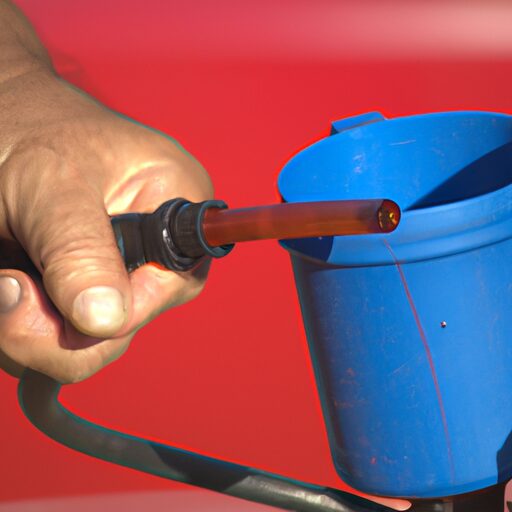Environmental Impact of Hydraulic Fluids: Unveiling the Untold Damage
Hydraulic fluids have untold damaging effects on the environment. From polluting water sources to causing serious harm to aquatic life, the environmental impact of hydraulic fluids is a significant concern.
These fluids often contain toxic chemicals that can contaminate soil and groundwater, leading to long-term ecological damage. The improper disposal of hydraulic fluids further worsens the situation, as it can lead to harmful emissions and pollution. The effects of hydraulic fluid contamination can be far-reaching and complex, making it crucial to address and minimize their environmental impact.
Understanding The Environmental Impact Of Hydraulic Fluids
Hydraulic fluids have a significant environmental impact, causing untold damage. Understanding this impact is essential for reducing the ecological harm caused by these fluids.
Hydraulic fluids play a critical role in various industries, powering heavy machinery and ensuring smooth operations. However, their widespread use also comes with a significant environmental impact that cannot be ignored. It is crucial to understand the consequences of hydraulic fluids on the environment to mitigate and minimize their damage.
In this section, we will delve into the subject, exploring the introduction to hydraulic fluids and their widespread use, as well as the importance of understanding their environmental impact.
Introduction To Hydraulic Fluids And Their Widespread Use
- Hydraulic fluids are substances specifically designed to transmit power and heat in hydraulic systems, converting mechanical energy into kinetic or potential energy.
- These fluids are used in a broad range of industries, including construction, manufacturing, transportation, and agriculture, to power equipment such as excavators, cranes, loaders, and tractors.
- The properties of hydraulic fluids, such as viscosity, lubricity, and thermal stability, make them excellent choices for transmitting force and ensuring the proper functioning of hydraulic systems.
The Importance Of Understanding Their Environmental Impact
- Hydraulic fluids have the potential to cause severe harm to the environment due to their composition and the way they are used. It is vital to assess and address their impact to protect our ecosystems.
- Here are some key reasons why understanding the environmental impact of hydraulic fluids is crucial:
- Contamination of soil and water sources: Improper handling or disposal of hydraulic fluids can lead to contamination of soil and water sources, posing a threat to plant and animal life. Spills, leaks, and improper disposal practices can result in long-lasting damage to the environment.
- Toxicity and bioaccumulation: Hydraulic fluids often contain toxic additives and heavy metals that can enter the food chain and accumulate in the tissues of organisms, gradually impacting their health and reproductive capabilities.
- Negative impact on aquatic life: Hydraulic fluid leaks or spills that find their way into rivers, lakes, or oceans can be highly toxic to aquatic organisms, leading to fish kills, disruptions in ecosystems, and long-term damage to marine life.
- Harmful effects on soil fertility: When hydraulic fluids contaminate soils, their chemical components can disrupt soil fertility, affecting plant growth and agricultural productivity.
By understanding the environmental impact of hydraulic fluids, we can implement preventive measures, develop more environmentally friendly alternatives, and ensure sustainable practices in hydraulic systems. It is a shared responsibility to protect our planet and preserve its delicate ecosystems for future generations.
Contamination And Pollution: Exploring The Consequences
Explore the hidden impacts of hydraulic fluids on the environment through an in-depth analysis of contamination and pollution. This eye-opening exploration uncovers the untold damage caused by these fluids and highlights the urgent need for sustainable solutions. Discover the consequences and take action for a cleaner, greener future.
Hydraulic fluids play a crucial role in the smooth operation of hydraulic systems, but their environmental impact is often overlooked. In this section, we will delve into the potential contamination and pollution caused by hydraulic fluids, shedding light on the untold damage they can inflict on our environment.
Examining The Sources Of Contamination:
- Equipment wear and tear: As hydraulic systems age, the degradation of seals, hoses, and other components can result in fluid contamination.
- External contaminants: Dust, dirt, water, and other foreign particles can infiltrate hydraulic systems, further contributing to contamination.
- Improper maintenance practices: Neglecting regular maintenance, such as failing to replace filters or using contaminated fluids, can introduce pollutants into the hydraulic system.
Dissecting The Chemical Composition Of Hydraulic Fluids:
- Petroleum-based fluids: Most hydraulic fluids in use today are derived from petroleum, containing a mixture of base oils, various additives, and viscosity modifiers.
- Synthetic fluids: These fluids are formulated from synthetic base stocks, offering improved performance and resistance to degradation.
- Biodegradable fluids: An eco-friendly alternative, biodegradable hydraulic fluids are derived from vegetable oils or synthetic esters, ensuring low environmental impact.
Analyzing The Consequences Of Fluid Leakage And Spillage:
- Soil contamination: Hydraulic fluid leakage or spillage can lead to soil pollution, rendering areas unsuitable for vegetation growth and disrupting the natural ecosystem.
- Water pollution: When hydraulic fluids find their way into water bodies, they can contaminate the aquatic environment, endangering marine life and impacting water quality.
- Health hazards: Exposure to hydraulic fluids, especially those containing harmful additives or chemicals, can pose health risks to both humans and animals.
Considering the sources of contamination, the chemical composition of hydraulic fluids, and the consequences of leakage and spillage, it becomes evident that addressing the environmental impact is of utmost importance. Implementing proper maintenance practices, using environmentally friendly fluids, and promptly addressing any leaks or spills are essential steps in mitigating the contamination and pollution caused by hydraulic fluids.
By doing so, we can make significant strides towards a greener and more sustainable future.
Degradation Of Ecosystems: How Hydraulic Fluids Impact Wildlife And Plant Life
Hydraulic fluids have a significant environmental impact, leading to the degradation of ecosystems and harm to wildlife and plant life. Their use can cause untold damage, highlighting the urgent need for sustainable alternatives.
Hydraulic fluids have long been essential for various industries due to their ability to transmit power and facilitate mechanical processes. However, it’s crucial to shed light on their detrimental effects on ecosystems, particularly wildlife, aquatic organisms, and plant life. Understanding the consequences of hydraulic fluid pollution is crucial for developing sustainable practices.
In this section, we will investigate the effects on aquatic ecosystems, examine the impact on terrestrial ecosystems, and unveil the consequences for vegetation and plant life.
Investigating The Effects On Aquatic Ecosystems:
- Contamination of water bodies: Hydraulic fluids often find their way into rivers, lakes, and oceans through leaks, accidental spills, or improper disposal. This contamination poses serious risks to aquatic organisms.
- Toxicity to marine life: The chemicals present in hydraulic fluids can be highly toxic to marine life, including fish, mollusks, and crustaceans. They can cause physiological and reproductive issues, leading to population declines.
- Disruption of the food chain: When hydraulic fluids contaminate water sources, they can harm primary producers such as algae and plankton. This disruption cascades up the food chain, affecting higher-level organisms such as fish and birds.
Examining The Impact On Terrestrial Ecosystems:
- Soil pollution: Leakage or improper handling of hydraulic fluids can result in soil pollution, affecting organisms living in or dependant on the soil for survival.
- Contamination of groundwater: Hydraulic fluids can seep into the soil, reaching groundwater reservoirs. This contamination poses risks to organisms relying on groundwater sources, including plants, insects, and animals.
- Ecological imbalances: Terrestrial ecosystems provide habitats for various organisms. The introduction of hydraulic fluids into these ecosystems can disrupt the delicate balance, leading to the decline of certain species and influencing the community structure.
Unveiling The Consequences For Vegetation And Plant Life:
- Reduced plant growth: Hydraulic fluid contamination can negatively impact plant growth and development due to its impact on soil quality and nutrient availability.
- Changes in plant physiology: Plants exposed to hydraulic fluid pollution may experience altered physiological processes, including reduced photosynthetic activity and impaired water and nutrient uptake.
- Loss of biodiversity: As hydraulic fluid pollution affects vegetation, it can lead to a decline in plant diversity. This, in turn, can have cascading effects on other organisms that rely on specific plant species for food and shelter.
It is of utmost importance to address the environmental impact of hydraulic fluids to protect our ecosystems’ health and preserve biodiversity. By promoting the adoption of eco-friendly hydraulic fluid alternatives and implementing proper handling and disposal practices, we can work towards mitigating the damage caused by these substances.
Climate Change Impact: The Role Of Hydraulic Fluids
Hydraulic fluids have a significant environmental impact, contributing to climate change damage that is often overlooked. Understanding the harmful effects can help raise awareness and promote the use of more eco-friendly alternatives.
Understanding The Greenhouse Gas Emissions Associated With Hydraulic Fluids
Hydraulic fluids play a crucial role in various industries, but their environmental impact often goes unnoticed. One significant concern is their contribution to greenhouse gas emissions, which directly affects climate change. Let’s delve into the specifics and understand the role hydraulic fluids play in these emissions.
- Hydraulic fluids contain additives and base oils that can be categorized into three groups – petroleum-based, bio-based, and synthetic.
- Petrochemical-based hydraulic fluids are predominantly used and have the highest impact on greenhouse gas emissions.
- The production and refining processes of petroleum-based hydraulic fluids generate carbon dioxide (CO2), contributing to the greenhouse effect.
- These fluids also release volatile organic compounds (VOCs) during operation, which further contribute to the formation of greenhouse gases.
- Bio-based hydraulic fluids, derived from renewable sources like vegetable oils, have a lower carbon footprint but still emit greenhouse gases during their production and use.
- Synthetic hydraulic fluids, made from chemical compounds, generally have the lowest greenhouse gas emissions.
Discussing The Impact On Global Warming
Hydraulic fluids’ impact on global warming is a concerning aspect that cannot be overlooked. Let’s examine how these fluids contribute to the overall warming of our planet.
- As hydraulic systems operate, the fluids undergo pressure and temperature changes, resulting in evaporation and leakage.
- The evaporation of hydraulic fluids releases greenhouse gases into the atmosphere, including methane (CH4) and nitrous oxide (N2O), both of which are potent contributors to global warming.
- Leakage from hydraulic systems is another significant concern. The release of fluids into the environment can contaminate soil and water, further exacerbating the effects of global warming.
- In addition to fluid leakage, the disposal of used hydraulic fluids is crucial. Improper disposal methods, such as incineration or release into bodies of water, can amplify environmental damage and contribute to global warming.
Examining The Contribution To Climate Change
The contribution of hydraulic fluids to climate change is a multifaceted issue that warrants thorough examination. Let’s explore the various aspects involved in this contribution.
- Hydraulic equipment consumes energy for operation, leading to the burning of fossil fuels and subsequent carbon emissions.
- The extraction, production, and transportation of petroleum-based hydraulic fluids involve significant energy consumption, resulting in additional greenhouse gas emissions.
- The carbon footprint of hydraulic fluids is influenced by their lifespan. If fluids are changed and replaced frequently, the emissions associated with their production and disposal increase.
- Implementing proper maintenance and fluid management practices can help reduce the overall impact on climate change by decreasing the need for frequent fluid replacement and minimizing leakage.
Considering the greenhouse gas emissions, impact on global warming, and contribution to climate change, it becomes evident that hydraulic fluids play a significant role in environmental degradation. Consequently, it is crucial for industries and individuals to adopt more sustainable practices and explore alternative fluid options to mitigate these harmful effects.
Marine Pollution: Hydraulic Fluids In Water Systems
Hydraulic fluids in water systems pose a significant environmental threat by causing marine pollution. The untold damage of these fluids reveals the dire state of our water ecosystems and emphasizes the urgent need for sustainable solutions.
Exploring The Impact On Marine Life And Habitats
Hydraulic fluids, when leaked or spilled, can have a serious impact on marine life and habitats. Here are some key points to consider:
- Hydraulic fluid contains harmful substances such as heavy metals, additives, and toxic chemicals that can contaminate water bodies.
- The release of hydraulic fluids into water systems can lead to the pollution of rivers, lakes, and oceans, posing a significant threat to aquatic ecosystems.
- Marine species such as fish, crustaceans, and marine mammals can be directly affected by the toxic properties of hydraulic fluids.
- The presence of contaminants in water can disrupt the natural balance of marine habitats, leading to negative impacts on the overall biodiversity.
Analyzing The Consequences For Fisheries And Food Chains
The contamination of water systems by hydraulic fluids can have severe consequences for fisheries and food chains. Consider the following:
- Fish and other organisms within the affected water bodies can absorb the toxic contaminants present in hydraulic fluids.
- The accumulation of these pollutants in the tissues of aquatic organisms can result in bioaccumulation and biomagnification, meaning that the toxins can become more concentrated as they move up the food chain.
- The consumption of contaminated fish by humans can lead to health risks due to the presence of toxic substances in the food chain.
- Fisheries can experience significant declines as contamination affects fish populations, potentially leading to economic losses for communities dependent on fishing industries.
Examining The Long-Term Effects Of Hydraulic Fluid Contamination In Water Systems
The long-term effects of hydraulic fluid contamination in water systems can be far-reaching and require careful consideration. Here are some key points to understand:
- Contaminants from hydraulic fluids can persist in the environment for extended periods, causing ongoing damage to water ecosystems.
- The toxic substances can alter water quality, impacting the health and survival of aquatic organisms over time.
- Chronic exposure to hydraulic fluid contaminants can lead to reproductive issues, developmental abnormalities, and overall population decline among marine species.
- The ecological repercussions of hydraulic fluid contamination can have cascading effects on the entire ecosystem, jeopardizing the stability and functionality of the affected water systems.
By acknowledging the impact on marine life and habitats, analyzing the consequences for fisheries and food chains, and examining the long-term effects of hydraulic fluid contamination in water systems, we can better understand the grave environmental repercussions of these substances.
It is crucial to raise awareness, take necessary preventive measures, and promote responsible use and disposal of hydraulic fluids to protect our precious marine ecosystems for future generations.
Regulatory Frameworks And Environmental Policies: Is It Enough?
The environmental impact of hydraulic fluids goes beyond what regulatory frameworks and environmental policies can address. Unveiling the untold damage they cause highlights the need for more comprehensive solutions to mitigate their negative effects.
Analyzing Current Regulations And Policies Surrounding Hydraulic Fluids:
- The environmental impact of hydraulic fluids cannot be overlooked, and governments around the world have implemented regulatory frameworks and policies to address this issue.
- Analyzing the current regulations and policies is crucial in understanding their effectiveness and identifying areas for improvement.
Evaluating The Effectiveness Of Existing Measures:
- To evaluate the effectiveness of existing measures, we need to consider various factors:
- Monitoring and reporting requirements: Are companies required to track and report their usage of hydraulic fluids?
- Environmental standards: Do the regulations set specific limits on the levels of harmful substances in hydraulic fluids?
- Reusability and recycling: Is there a focus on promoting the reuse and recycling of hydraulic fluids?
- Education and awareness: Are there initiatives in place to educate businesses and individuals about the proper handling and disposal of hydraulic fluids?
Discussing The Need For Stricter Regulations And Enforcement:
- While current regulations and policies are steps in the right direction, there is a need for stricter regulations and stronger enforcement to mitigate the environmental impact of hydraulic fluids. Some key points include:
- Technology advancements: Stricter regulations can drive companies to adopt more environmentally friendly hydraulic fluids and technologies.
- Preventing leaks and spills: Stronger enforcement can ensure that companies take necessary measures to prevent leaks and spills during manufacturing, storage, and transportation of hydraulic fluids.
- Penalties for non-compliance: Stricter regulations combined with severe penalties can deter businesses from disregarding environmental regulations.
- International cooperation: Collaborating with other countries to establish global standards can enhance the effectiveness of regulations and reduce the cross-border environmental impact.
Remember, protecting the environment requires a collective effort, and addressing the environmental impact of hydraulic fluids is no exception. By analyzing current regulations, evaluating their effectiveness, and advocating for stricter regulations and enforcement, we can work towards a cleaner and more sustainable future.
Sustainable Alternatives: A Solution To The Environmental Impact
Uncovering the true environmental impact of hydraulic fluids reveals the urgent need for sustainable alternatives. These fluids not only harm ecosystems but also contribute to climate change. Employing eco-friendly alternatives can mitigate the damage caused and pave the way for a greener future.
Many industries heavily rely on hydraulic systems for their operations. However, the use of traditional hydraulic fluids can have a significant negative impact on the environment. Thankfully, there are sustainable alternatives available that not only minimize environmental damage but also uphold the efficiency and functionality of hydraulic systems.
In this section, we will explore these environmentally-friendly hydraulic fluid alternatives, analyze their potential benefits and drawbacks, and discuss their role in mitigating environmental damage.
Introducing Environmentally-Friendly Hydraulic Fluid Alternatives
- Vegetable-based hydraulic fluids: These are derived from renewable plant-based sources such as soybeans, rapeseed, and canola.
- Bio-degradable hydraulic fluids: These fluids are designed to break down naturally over time, reducing the risk of contaminating soil, water, and wildlife.
- Water-based hydraulic fluids: These fluids have a higher water content, reducing the reliance on petroleum-based additives and minimizing environmental impact.
- Synthetic ester-based hydraulic fluids: Made from synthetic compounds, these fluids provide excellent lubrication properties and have a low toxicity level.
- Polyalphaolefins (PAOs): These synthetic fluids offer superior chemical stability, thermal resistance, and biodegradability.
Analyzing Their Potential Benefits And Drawbacks
- Vegetable-based hydraulic fluids:
- Benefits: Renewable source, biodegradable, low toxicity, high flash point.
- Drawbacks: Limited temperature range, potential compatibility issues with certain materials.
- Bio-degradable hydraulic fluids:
- Benefits: Biodegradable, non-toxic, reduced environmental impact, suitable for sensitive ecosystems.
- Drawbacks: Costlier than traditional hydraulic fluids, limited availability, potential performance limitations in high-pressure systems.
- Water-based hydraulic fluids:
- Benefits: Lower environmental impact, reduced flammability, compatible with many materials.
- Drawbacks: Susceptible to corrosion, reduced lubricity, requires additional anti-corrosion additives.
- Synthetic ester-based hydraulic fluids:
- Benefits: Good lubrication properties, high thermal stability, low toxicity, biodegradable.
- Drawbacks: Higher cost, potential compatibility issues with certain seals and elastomers, limited viscosity options.
- Polyalphaolefins (PAOs):
- Benefits: Excellent oxidation stability, wide temperature range, good anti-wear properties, readily available.
- Drawbacks: Higher cost, potential compatibility issues with certain materials, limited biodegradability.
Discussing Their Role In Mitigating Environmental Damage
The sustainable hydraulic fluid alternatives mentioned above play a crucial role in minimizing the environmental impact caused by traditional hydraulic fluids. By adopting these alternatives, industries can enjoy several environmental benefits, such as:
- Reducing the risk of soil and water contamination.
- Minimizing the release of harmful substances into the atmosphere.
- Preserving sensitive ecosystems and wildlife habitats.
- Promoting the use of renewable and biodegradable resources.
- Meeting regulatory requirements and environmental standards.
Moreover, these sustainable alternatives do not compromise the efficiency and functionality of hydraulic systems. They maintain optimal performance and contribute to the longevity and reliability of equipment.
The adoption of environmentally-friendly hydraulic fluid alternatives is essential for industries aiming to reduce their environmental footprint. Each type of alternative has its own benefits and drawbacks, requiring careful consideration and appropriate selection based on the specific needs of the application.
By embracing sustainable alternatives, industries can continue their operations while minimizing ecological damage and ensuring a cleaner and greener future.

Credit: www.theguardian.com
Corporate Responsibility: The Role Of Industries And Manufacturers
Industries and manufacturers have a significant role in corporate responsibility, particularly regarding the environmental impact of hydraulic fluids. This article delves into the untold damage caused by these fluids and the need for industries to take responsibility for minimizing their environmental footprint.
Encouraging Responsible Production And Disposal Of Hydraulic Fluids:
- Manufacturers and industries play a crucial role in reducing the environmental impact of hydraulic fluids. By implementing responsible production practices and promoting proper disposal methods, they can contribute to a more sustainable future.
- Here are some key points to encourage corporate responsibility in this regard:
- Implementing eco-friendly manufacturing processes: Industries can adopt cleaner production methods that minimize waste generation and reduce the use of harmful chemicals in hydraulic fluids.
- Using biodegradable hydraulic fluids: Manufacturers can develop and promote the use of biodegradable hydraulic fluids that have a reduced impact on the environment.
- Conducting environmental impact assessments: Industries should regularly assess the environmental impact of their hydraulic fluid products and take necessary steps to mitigate any negative effects.
- Collaborating with regulatory bodies: It is essential for manufacturers and industries to work closely with regulatory bodies to ensure adherence to environmental regulations and foster responsible hydraulic fluid production.
- Encouraging industry-wide certifications: Promoting certifications such as ISO 14001, which focuses on environmental management systems, can help manufacturers demonstrate their commitment to sustainability.
Discussing The Importance Of Proper Waste Management:
- Proper waste management is crucial to minimizing the negative environmental impact of hydraulic fluids. Industries and manufacturers can contribute to this by adopting effective waste management practices. Here are some key points to consider:
- Implementing recycling programs: Industries should establish recycling programs to properly manage used hydraulic fluids, allowing for their reuse or safe disposal.
- Educating employees: Companies must educate their employees about the importance of proper waste management techniques and provide training on handling and disposing of hydraulic fluids.
- Monitoring waste disposal: Manufacturers should regularly monitor the disposal of hydraulic fluid waste to ensure compliance with regulations and prevent any potential harm to the environment.
- Supporting research and development: Investing in research and development can help identify innovative ways to manage hydraulic fluid waste, such as developing more efficient filtration and purification techniques.
- Collaborating with waste management organizations: Industries should collaborate with waste management organizations to ensure their hydraulic fluid waste is handled and disposed of responsibly.
Highlighting The Need For Sustainable Practices Within The Industry:
- Achieving sustainable practices within the hydraulic fluid industry is essential for minimizing its environmental impact. Here are some key points to emphasize the need for sustainability:
- Conserving resources: Industries should focus on minimizing resource consumption by adopting energy-efficient manufacturing processes and optimizing hydraulic fluid formulations.
- Scaling up recycling initiatives: Manufacturers should strive to increase the recycling and reuse of hydraulic fluids, reducing the demand for newly produced fluids and lowering their environmental impact.
- Promoting research into sustainable alternatives: Investing in research and development can lead to the discovery and utilization of sustainable alternatives to conventional hydraulic fluids, further reducing environmental damage.
- Engaging in industry-wide sustainability initiatives: Industries should actively participate in collaborative efforts within the hydraulic fluid sector to develop and promote sustainable practices industry-wide.
- Educating consumers: Manufacturers can play a vital role in raising awareness among consumers about the importance of sustainable hydraulic fluid practices and the benefits of using environmentally friendly products.
Frequently Asked Questions Of Environmental Impact Of Hydraulic Fluids: Unveiling The Untold Damage
How Bad Is Hydraulic Fluid For The Environment?
Hydraulic fluid can be harmful to the environment due to its potential to contaminate soil and water.
What Are The Long Term Problems Caused By Hydraulic Fluid?
Hydraulic fluid can cause long term problems like damage to seals, corrosion, and system failure.
Why Are Hydraulic Fluids Hazardous To Human Beings?
Hydraulic fluids are hazardous to humans due to their toxic and corrosive properties, posing health risks.
Will Hydraulic Oil Damage Grass?
Hydraulic oil won’t damage grass as long as spills are quickly cleaned up.
Conclusion
To summarize, the environmental impact of hydraulic fluids is a topic of great concern. We have explored how these substances, when not properly managed, can seep into the earth and contaminate soil and water sources. The repercussions are far-reaching, affecting not only wildlife but also human health.
It is essential to take proactive measures to minimize the use of hazardous hydraulic fluids and promote environmentally friendly alternatives. By implementing sustainable practices, such as proper disposal and recycling, we can help mitigate the damage caused by these fluids.
Furthermore, manufacturers and industries must prioritize the development and use of biodegradable and non-toxic hydraulic fluids. It is in our hands to protect our environment and ensure a sustainable future for generations to come. Let us all play our part in safeguarding our planet from the untold damage inflicted by hydraulic fluids.







